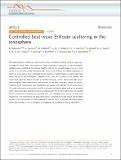Controlled beat-wave Brillouin scattering in the ionosphere
Abstract
Stimulated Brillouin scattering experiments in the ionospheric plasma using a single electromagnetic pump wave have previously been observed to generate an electromagnetic sideband wave, emitted by the plasma, together with an ion- acoustic wave. Here we report results of a controlled, pump and probe beat-wave driven Brillouin scattering experiment, in which an ion-acoustic wave generated by the beating of electromagnetic pump and probe waves, results in electromagnetic sideband waves that are recorded on the ground. The experiment used the EISCAT facility in northern Norway, which has several high power electromagnetic wave transmitters and receivers in the radio frequency range. An electromagnetic pump consisting of large amplitude radio waves with ordinary (O) or extraordinary (X) mode polarization was injected into the overhead ionosphere, along with a less powerful probe wave, and radio sideband emissions observed on the ground clearly show stimulated Brillouin emissions at frequencies agreeing with, and changing with, the pump and probe frequencies. The experiment was simulated using a numerical full-scale model which clearly supports the interpretation of the experimental results. Such controlled beat-wave experiments demonstrate a way of remotely investigating the ionospheric plasma parameters.
Citation
Eliasson , B , Senior , A , Rietveld , M , Phelps , A D R , Cairns , R A , Ronald , K , Speirs , D C , Trines , R M G M , McCrea , I , Bamford , R , Mendonça , J T & Bingham , R 2021 , ' Controlled beat-wave Brillouin scattering in the ionosphere ' , Nature Communications , vol. 12 , 6209 . https://doi.org/10.1038/s41467-021-26305-9
Publication
Nature Communications
Status
Peer reviewed
ISSN
2041-1723Type
Journal article
Rights
Copyright © The Author(s) 2021. This article is licensed under a Creative Commons Attribution 4.0 International License, which permits use, sharing, adaptation, distribution and reproduction in any medium or format, as long as you give appropriate credit to the original author(s) and the source, provide a link to the Creative Commons license, and indicate if changes were made. The images or other third party material in this article are included in the article’s Creative Commons license, unless indicated otherwise in a credit line to the material. If material is not included in the article’s Creative Commons license and your intended use is not permitted by statutory regulation or exceeds the permitted use, you will need to obtain permission directly from the copyright holder. To view a copy of this license, visit http://creativecommons.org/licenses/by/4.0/.
Description
The authors acknowledge support from the Engineering and Physical Sciences Research Council (EPSRC), UK, grants EP/M009386/1, EP/R004773/1, and EP/R034737/1. EISCAT is an international association supported by research organisations in China (CRIRP), Finland (SA), Japan (NIPR and ISEE), Norway (NFR), Sweden (VR), and the United Kingdom (UKRI).Collections
Items in the St Andrews Research Repository are protected by copyright, with all rights reserved, unless otherwise indicated.

